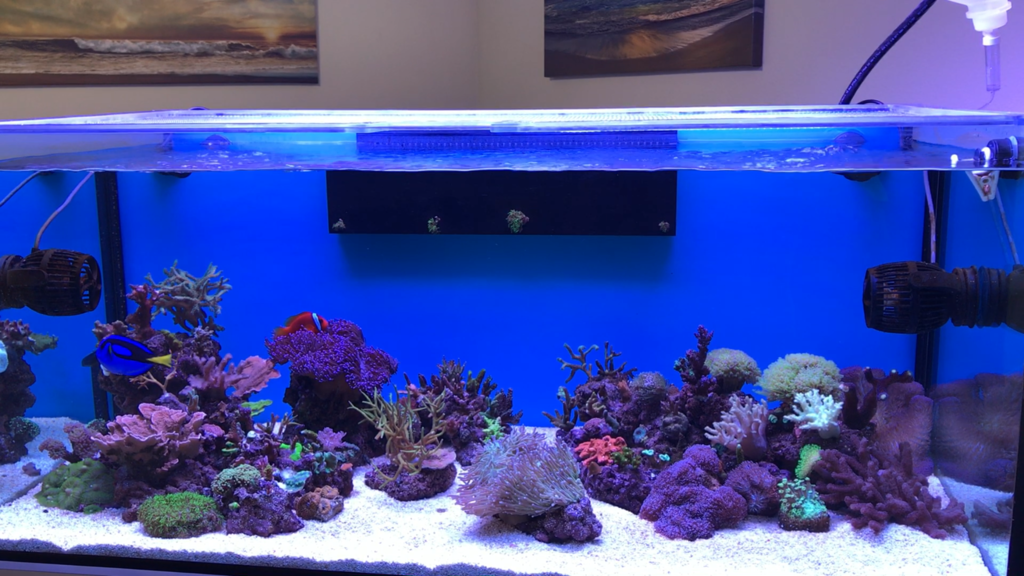This is my 11th month with Triton.
I thought that I share with you guys my experiences and the theories I started to believe in and rely on.
Some are strictly related to Triton some other are more general.
And sorry for my English. I'm Hungarian.
THE "SWEET" SEA WATER
First of all, I recommend 2 must read scientific studies to people who want to play with the Triton Method:
1. http://www.int-res.com/articles/ab_oa/b010p131.pdf
2. http://www.ncbi.nlm.nih.gov/pmc/articles/PMC1218179/pdf/9078264.pdf
What do they suggest?
1. Algae seems to release carbohydrates, especially glucose (a form of sugar)
2. Corals, including SPS corals seem to be able to use glucose to synthesize at least 14 out of the 17 studied amino acids including all the 8 essential amino acids.
I think if you combine these 2 points you will see how Triton Method is supposed to work. Or at least how algae refugium is more than just a tool to control NO3 and PO4.
But I also assume that most people - just like I did at the beginning - think that the nutrient export provided by the algae refugium is strictly related and also very limited by the growth capacity of the algae species. If you recall the suggestion by the first study you will immediately see more potential in the algae: I think that the glucose released by the algae is used as an organic carbon source by bacteria as well, just like in the Vodka or in the Zeovit methods. I believe that this is much better than any manual carbon dosing. Why? Because it is naturally controlled. The big risk with manual carbon dosing is that you do not know when to stop before it is too late. I think in the Triton Method the way how algae refugium participates in the nutrient export is not just through the direct consumption of nitrogen and phosphorus (via growth) but also as a facilitator of the bacterial activity. As long as nutrients are high algae is thriving well so it also provides the bacteria with good amount of organic carbon. But once nitrogen is getting very low bio-activity of the algae goes down so its organic carbon release as well.
SEA URCHINS BECAME MY BEST FRIENDS
Since the Triton Method encourages algae growth algae will grow everywhere not just in the refugium. I do not say that I noticed an outbreak of any algae from the refugium but I noticed that the surface of my live rock became "dirtier". The problem with this is that the live rock is supposed to be our MAIN biological filter media (I believe that it is much better than siphorax or matrix) but detritus, coralline algae, and other "web like" algae can close the little pores, so make the live rock much less efficient. This is when sea urchins can do magic. One urchin per 100 liter will keep your live rock clean.
Live rock complements the refugium. They are the yin and the yang of the system so both require attention and care.
LOW NUTRITION IS NOT EVIL
The second main point which I wanted to highlight - not strictly related to the Triton Method - is that how NO3 dosing might be a false concept. I frequently discover new posts of people about their NO3 dosing regime to keep NO3 measurable. So before we jump into some other Triton Method experiences let me share with you my point of view about inorganic nutrients. The reason why I think this is worth to be discussed here is that with the Triton Method you may reach undetectable PO4 and NO3 (with the standard, hobby level test kits at least) which may be considered as the "evil SPS killer ULNS zone" but it is not. So I think:
1. NO3 dosing is a self-deception
NO3 is only a mid-step of the nitrogen cycle indicating the state of the nitrification, but hard to believe that NO3 dosing can fix a malfunctioning cycle. If you "naturally" want more NO3 you need more ammonia or urea in the system (That is why more fish helps - on the other hand their feeding also increase PO4 unfortunately...) FYI In my previous tanks I also played a lot with NO3 and NH4 with no result.
2. Starving corals can not be saved with NO3
As far as I know SPS/LPS corals can not directly use NO3. The way how they consume inorganic nutrient is very likely via zooxhantella and the preferred form is ammonia or urea. Even though zooxhantella's job is to transform inorganic N into organic sugar using the power form the light, studies suggests that this source of sugar alone is not enough for the coral to survive.
3. NO3 is rather a food for bacteria
NO3 is the preferred food source for many bacteria (it requires less energy to deal with than with ammonia). Most tanks run out of nitrogen faster than phosphorus that is why NO3 dosing helps to lower PO4 especially if the primary nutrient export is heavily rely on an overdriven bacterial growth like Zoevit, pellet, vodka, etc. But these systems need additional organic carbon dosing as well since the limiting nutrient for bacteria is the carbon and not the nitrogen.
4. Inorganic dosing can easily lead to cyano.
In a nitrogen limited aquarium if you start dosing any inorganic nitrogen of phosphorus there is a high chance that it will lead to cyano. Cyano is a super-survivor so that it can adopt faster to any new food sources than other bacteria.
5. PO4 is not an enemy, and it will not make a coral brown.
PO4 does not make SPS corals brown. Ammonia + PO4 together does. Why is this interesting? At the natural coral reefs PO4 is around 0,01-0,03 - this is in line with the values we try to achieve in a tank - but this PO4 value is never paired with 5-10 NO3 at the coral reef which would be an indicator of an extremely high ammonia load (That is why chasing Redfield makes no sense for me at all!). At the coral reef both ammonia and NO3 levels are very low. Eg. NO3 is around 0,01 ppm.
6. Zero measurable NO3 or PO4 does not mean that you do not have enough.
As far as I consider there are two types of zero (or very low) nutrient. In the first one the excess nutrient is very quickly consumed with no or below detection level left-over. In the second one there is no nutrient at all. In both case our tests are showing 0, however at the first one the tank is thriving while at the second one it is dying.
7. Lack of certain trace elements (or/and light) is a bigger issue than low nutrient
I have no scientific proof but I think that sometimes higher nutrient levels solve some coral related issue such as growth or/and colors not because the lack of nutrient was a real issue but because the lack of certain key trace elements (and light) did not allow the coral perform efficiently at a lower level nutrient level.
Here are the scientific papers I gathered over years related to may thoughts above:
1. About how NO3 is good for zooxanthellae alone:
Nitrate increases zooxanthellae population density and reduces skeletogenesis in corals
http://mgg.rsmas.miami.edu/groups/bi...2114319668.pdf
2. About how NH4 is even better for zooxanthellae:
The population dynamics of symbiotic zooxanthellae in the coral Pocillopora damicornis exposed to elevated ammonium (NH4Cl) concentrations.
http://hl-128-171-57-22.library.mano...n3-263-272.pdf
3. About how NO3 and NH4 makes coral brown and how PO4+NO3 or PO4+NH4 makes them even more while PO4 alone not:
The Effect of External Nutrient Resources on the Population Dynamics of Zooxanthellae in a Reef Coral
https://www.researchgate.net/publica...n_a_Reef_Coral
4. And a recent one about how inorganic nutrient are not enough:
Feature Study: Corals as the ultimate vegans?
http://www.advancedaquarist.com/2016/6/aafeature
TRACE ELEMENTS AND LIGHT ARE THE REAL CHALLENGE
At point 7 above I said "Lack of certain trace elements (or/and light) is a bigger issue than low nutrient" But how?
When I had my first ICP done I thought that adding some trace elements as it was recommend will do magic, and the next day my SPS corals will be 2x more colorful But in reality it just made problems. Whenever I patched my tank with occasional dosage of trace elements, especially when I pulled up a value from 0 to NSW I rather noticed some weird algae or bacterial slime appearing than color improvement.
But in reality it just made problems. Whenever I patched my tank with occasional dosage of trace elements, especially when I pulled up a value from 0 to NSW I rather noticed some weird algae or bacterial slime appearing than color improvement.
I'm a big believer of NSW values, so I decided to design a solution for maintaining NSW trace element levels as opposed to achieve them just for a few moments every once in awhile.
So I tested my tank water every 30 days for 4 months. By the end of this period I knew exactly what was needed on a daily bases to offset my tank consumption. I know that Triton does not recommend us to mix different traces into one but I thought - even though I have very limited knowledge about chemistry - that I will make my own patch for the Base Elements to be dosed like the "5th" component of the balling 24/7. To avoid precipitation and degradation of elements I decided to use high dilution and mix elements in an amount which will not last longer than a week.
Even though I thought that I really did something "revolutionary" coral colors did not significantly improved.
I had low nutrient, close to NSW level stable trace elements, rock stable Kh, salinity, etc. What else could be missing?
Since I had 6x54W Ati Powermodul over my 120x45x45 (cm) tank I have never thought that light will be ever an issue.
But it was.
I think that certain trace elements (including especially manganese and iron) make zooxanthellae thrive at low nutrient as well. The host corals have no interest to lower their amount as long as they get what they want: sugar. The only way to convince the corals to expel some of their simbionts if they are sure to get the same amount of sugar. The key here is light. More light increases the performance of zooxanthellae so the coral needs less of them.
So I finally added led strips and I also changed the tube combination.
Original was: 3x Ati BluePlus + 3x Ati CoralPlus (app. 11.000 lumen)
Now I have: 4x Ati BluePlus + 2x Ati TrueActinic + 72W 4000K SMD LED strip + 60W 400nm SMD LED (app 15.000 lumen, with a very likely higher PUR due to more 400-440nm light, and a much even spectrum for chromoproteins to encourage red and yellow colors)
And finally the magic started happening for me.
SIZE MATTERS
The final learning which I wanted to share with you her is that I think that refugium is about size. Not necessarily in metric volume but in footprint for sure. Algae need light, so depth is counterproductive, and since algae has a key role in both feeding our corals and controlling bacterial activity we need to have a lot. If the "glucose" theory is really working it is very likely happening in the nano-molar end of the scale so a handful of Chaeto will not make any difference in a tank.
I also recommend you to start with a significant amount of algae and with several different species. If you start growing a small ball of Chateo alone - especially in a matured tank like mine was - it may take 6 months to reach something. Of course I also started with a small ball of Chaeto alone, which did not do too much in the first 2 months except slow growing. So I started adding new species and I also increased the amount of the well performing species GRADUALLY (E.g in my case non of the Caulerpa species worked but Ulva and especially red Gracilaria started growing like weed)
Triton suggests that the biodiversity of the refugium is important from the nutrient consumption point of view but I also think - as the first algae study revealed for me - that it is important from the "exudate" composition point of view as well. Not glucose is the only carbohydrate which is released by algae, and on top of carbohydrates they release proteins as well. It is very likely that the different algae species release different mix of these organic matters.
STABILITY
I used to have coral colors like this with the Zeovit system as well. The difference is that within the Zeovit world I was not able to maintain the results and I had my tank crashed 2x (STN, fading, no growth, cyano, etc) In both cases my tank started showing "the signs" within 1-2 months after the corals had reached their beauty peek.
With Triton I have very nice colors since 3-4 moths (at least)
HARDWARES
Salinity must be checked frequently. I recommend you to buy a lab grade conductivity meter instead of a refractometer. It will help you to evaluate you RO/DI water as well. I use: Greisinger GLF100
PHOTOS
Disclaimer:
- the corals are not recently bought corals and especially not from a fresh import
- I used 4000k LED light to take the photos with my iPhone SE and I added some saturation and sharpness in Photoshop
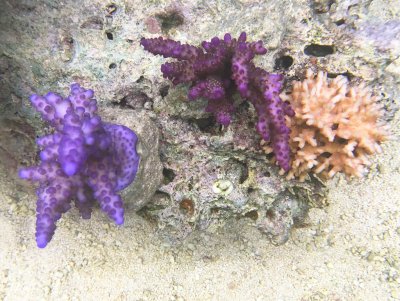
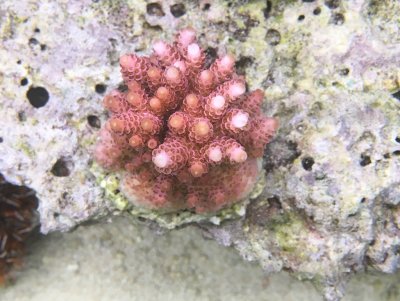
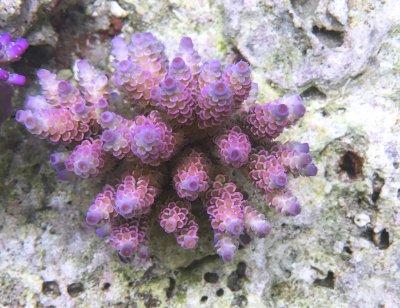
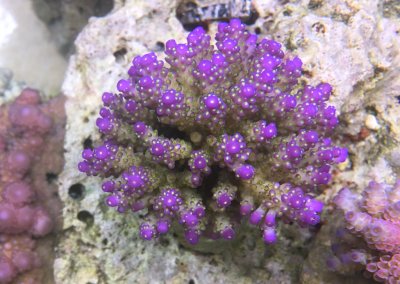
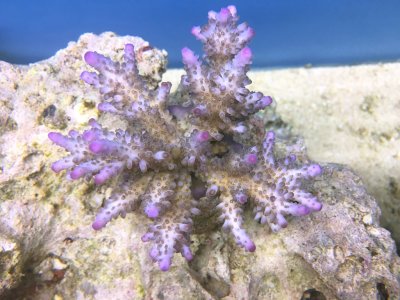
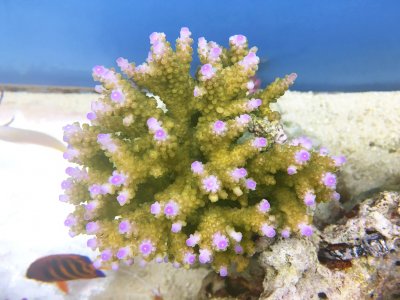
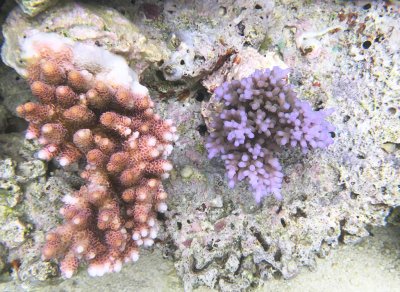
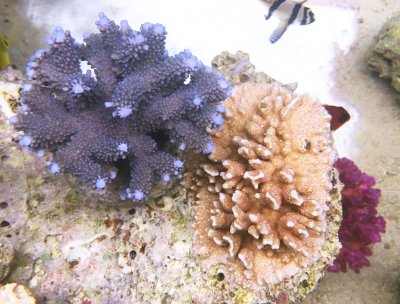
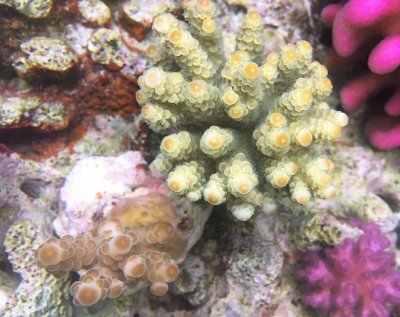
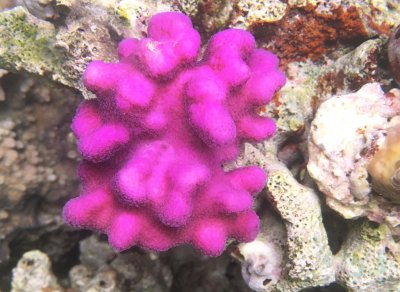
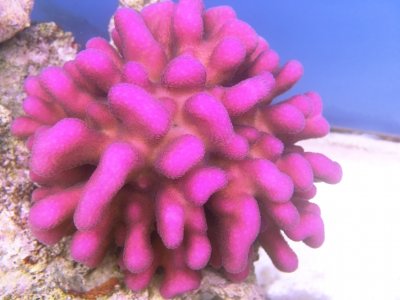
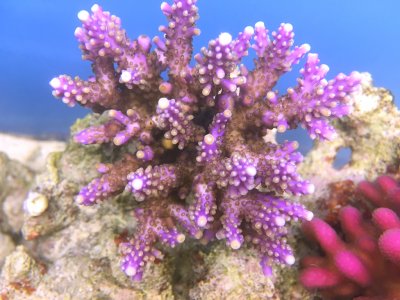
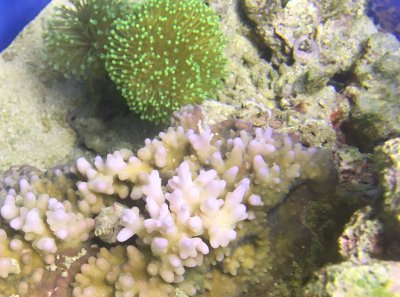
I thought that I share with you guys my experiences and the theories I started to believe in and rely on.
Some are strictly related to Triton some other are more general.
And sorry for my English. I'm Hungarian.
THE "SWEET" SEA WATER
First of all, I recommend 2 must read scientific studies to people who want to play with the Triton Method:
1. http://www.int-res.com/articles/ab_oa/b010p131.pdf
2. http://www.ncbi.nlm.nih.gov/pmc/articles/PMC1218179/pdf/9078264.pdf
What do they suggest?
1. Algae seems to release carbohydrates, especially glucose (a form of sugar)
2. Corals, including SPS corals seem to be able to use glucose to synthesize at least 14 out of the 17 studied amino acids including all the 8 essential amino acids.
I think if you combine these 2 points you will see how Triton Method is supposed to work. Or at least how algae refugium is more than just a tool to control NO3 and PO4.
But I also assume that most people - just like I did at the beginning - think that the nutrient export provided by the algae refugium is strictly related and also very limited by the growth capacity of the algae species. If you recall the suggestion by the first study you will immediately see more potential in the algae: I think that the glucose released by the algae is used as an organic carbon source by bacteria as well, just like in the Vodka or in the Zeovit methods. I believe that this is much better than any manual carbon dosing. Why? Because it is naturally controlled. The big risk with manual carbon dosing is that you do not know when to stop before it is too late. I think in the Triton Method the way how algae refugium participates in the nutrient export is not just through the direct consumption of nitrogen and phosphorus (via growth) but also as a facilitator of the bacterial activity. As long as nutrients are high algae is thriving well so it also provides the bacteria with good amount of organic carbon. But once nitrogen is getting very low bio-activity of the algae goes down so its organic carbon release as well.
SEA URCHINS BECAME MY BEST FRIENDS
Since the Triton Method encourages algae growth algae will grow everywhere not just in the refugium. I do not say that I noticed an outbreak of any algae from the refugium but I noticed that the surface of my live rock became "dirtier". The problem with this is that the live rock is supposed to be our MAIN biological filter media (I believe that it is much better than siphorax or matrix) but detritus, coralline algae, and other "web like" algae can close the little pores, so make the live rock much less efficient. This is when sea urchins can do magic. One urchin per 100 liter will keep your live rock clean.
Live rock complements the refugium. They are the yin and the yang of the system so both require attention and care.
LOW NUTRITION IS NOT EVIL
The second main point which I wanted to highlight - not strictly related to the Triton Method - is that how NO3 dosing might be a false concept. I frequently discover new posts of people about their NO3 dosing regime to keep NO3 measurable. So before we jump into some other Triton Method experiences let me share with you my point of view about inorganic nutrients. The reason why I think this is worth to be discussed here is that with the Triton Method you may reach undetectable PO4 and NO3 (with the standard, hobby level test kits at least) which may be considered as the "evil SPS killer ULNS zone" but it is not. So I think:
1. NO3 dosing is a self-deception
NO3 is only a mid-step of the nitrogen cycle indicating the state of the nitrification, but hard to believe that NO3 dosing can fix a malfunctioning cycle. If you "naturally" want more NO3 you need more ammonia or urea in the system (That is why more fish helps - on the other hand their feeding also increase PO4 unfortunately...) FYI In my previous tanks I also played a lot with NO3 and NH4 with no result.
2. Starving corals can not be saved with NO3
As far as I know SPS/LPS corals can not directly use NO3. The way how they consume inorganic nutrient is very likely via zooxhantella and the preferred form is ammonia or urea. Even though zooxhantella's job is to transform inorganic N into organic sugar using the power form the light, studies suggests that this source of sugar alone is not enough for the coral to survive.
3. NO3 is rather a food for bacteria
NO3 is the preferred food source for many bacteria (it requires less energy to deal with than with ammonia). Most tanks run out of nitrogen faster than phosphorus that is why NO3 dosing helps to lower PO4 especially if the primary nutrient export is heavily rely on an overdriven bacterial growth like Zoevit, pellet, vodka, etc. But these systems need additional organic carbon dosing as well since the limiting nutrient for bacteria is the carbon and not the nitrogen.
4. Inorganic dosing can easily lead to cyano.
In a nitrogen limited aquarium if you start dosing any inorganic nitrogen of phosphorus there is a high chance that it will lead to cyano. Cyano is a super-survivor so that it can adopt faster to any new food sources than other bacteria.
5. PO4 is not an enemy, and it will not make a coral brown.
PO4 does not make SPS corals brown. Ammonia + PO4 together does. Why is this interesting? At the natural coral reefs PO4 is around 0,01-0,03 - this is in line with the values we try to achieve in a tank - but this PO4 value is never paired with 5-10 NO3 at the coral reef which would be an indicator of an extremely high ammonia load (That is why chasing Redfield makes no sense for me at all!). At the coral reef both ammonia and NO3 levels are very low. Eg. NO3 is around 0,01 ppm.
6. Zero measurable NO3 or PO4 does not mean that you do not have enough.
As far as I consider there are two types of zero (or very low) nutrient. In the first one the excess nutrient is very quickly consumed with no or below detection level left-over. In the second one there is no nutrient at all. In both case our tests are showing 0, however at the first one the tank is thriving while at the second one it is dying.
7. Lack of certain trace elements (or/and light) is a bigger issue than low nutrient
I have no scientific proof but I think that sometimes higher nutrient levels solve some coral related issue such as growth or/and colors not because the lack of nutrient was a real issue but because the lack of certain key trace elements (and light) did not allow the coral perform efficiently at a lower level nutrient level.
Here are the scientific papers I gathered over years related to may thoughts above:
1. About how NO3 is good for zooxanthellae alone:
Nitrate increases zooxanthellae population density and reduces skeletogenesis in corals
http://mgg.rsmas.miami.edu/groups/bi...2114319668.pdf
2. About how NH4 is even better for zooxanthellae:
The population dynamics of symbiotic zooxanthellae in the coral Pocillopora damicornis exposed to elevated ammonium (NH4Cl) concentrations.
http://hl-128-171-57-22.library.mano...n3-263-272.pdf
3. About how NO3 and NH4 makes coral brown and how PO4+NO3 or PO4+NH4 makes them even more while PO4 alone not:
The Effect of External Nutrient Resources on the Population Dynamics of Zooxanthellae in a Reef Coral
https://www.researchgate.net/publica...n_a_Reef_Coral
4. And a recent one about how inorganic nutrient are not enough:
Feature Study: Corals as the ultimate vegans?
http://www.advancedaquarist.com/2016/6/aafeature
TRACE ELEMENTS AND LIGHT ARE THE REAL CHALLENGE
At point 7 above I said "Lack of certain trace elements (or/and light) is a bigger issue than low nutrient" But how?
When I had my first ICP done I thought that adding some trace elements as it was recommend will do magic, and the next day my SPS corals will be 2x more colorful
I'm a big believer of NSW values, so I decided to design a solution for maintaining NSW trace element levels as opposed to achieve them just for a few moments every once in awhile.
So I tested my tank water every 30 days for 4 months. By the end of this period I knew exactly what was needed on a daily bases to offset my tank consumption. I know that Triton does not recommend us to mix different traces into one but I thought - even though I have very limited knowledge about chemistry - that I will make my own patch for the Base Elements to be dosed like the "5th" component of the balling 24/7. To avoid precipitation and degradation of elements I decided to use high dilution and mix elements in an amount which will not last longer than a week.
Even though I thought that I really did something "revolutionary" coral colors did not significantly improved.
I had low nutrient, close to NSW level stable trace elements, rock stable Kh, salinity, etc. What else could be missing?
Since I had 6x54W Ati Powermodul over my 120x45x45 (cm) tank I have never thought that light will be ever an issue.
But it was.
I think that certain trace elements (including especially manganese and iron) make zooxanthellae thrive at low nutrient as well. The host corals have no interest to lower their amount as long as they get what they want: sugar. The only way to convince the corals to expel some of their simbionts if they are sure to get the same amount of sugar. The key here is light. More light increases the performance of zooxanthellae so the coral needs less of them.
So I finally added led strips and I also changed the tube combination.
Original was: 3x Ati BluePlus + 3x Ati CoralPlus (app. 11.000 lumen)
Now I have: 4x Ati BluePlus + 2x Ati TrueActinic + 72W 4000K SMD LED strip + 60W 400nm SMD LED (app 15.000 lumen, with a very likely higher PUR due to more 400-440nm light, and a much even spectrum for chromoproteins to encourage red and yellow colors)
And finally the magic started happening for me.
SIZE MATTERS
The final learning which I wanted to share with you her is that I think that refugium is about size. Not necessarily in metric volume but in footprint for sure. Algae need light, so depth is counterproductive, and since algae has a key role in both feeding our corals and controlling bacterial activity we need to have a lot. If the "glucose" theory is really working it is very likely happening in the nano-molar end of the scale so a handful of Chaeto will not make any difference in a tank.
I also recommend you to start with a significant amount of algae and with several different species. If you start growing a small ball of Chateo alone - especially in a matured tank like mine was - it may take 6 months to reach something. Of course I also started with a small ball of Chaeto alone, which did not do too much in the first 2 months except slow growing. So I started adding new species and I also increased the amount of the well performing species GRADUALLY (E.g in my case non of the Caulerpa species worked but Ulva and especially red Gracilaria started growing like weed)
Triton suggests that the biodiversity of the refugium is important from the nutrient consumption point of view but I also think - as the first algae study revealed for me - that it is important from the "exudate" composition point of view as well. Not glucose is the only carbohydrate which is released by algae, and on top of carbohydrates they release proteins as well. It is very likely that the different algae species release different mix of these organic matters.
STABILITY
I used to have coral colors like this with the Zeovit system as well. The difference is that within the Zeovit world I was not able to maintain the results and I had my tank crashed 2x (STN, fading, no growth, cyano, etc) In both cases my tank started showing "the signs" within 1-2 months after the corals had reached their beauty peek.
With Triton I have very nice colors since 3-4 moths (at least)
HARDWARES
Salinity must be checked frequently. I recommend you to buy a lab grade conductivity meter instead of a refractometer. It will help you to evaluate you RO/DI water as well. I use: Greisinger GLF100
PHOTOS
Disclaimer:
- the corals are not recently bought corals and especially not from a fresh import
- I used 4000k LED light to take the photos with my iPhone SE and I added some saturation and sharpness in Photoshop















